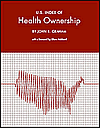Gov. David A. Paterson just headed off a budget crisis by persuading legislators to cut spending by a billion dollars. But with the three-year deficit projected at $26.2 billion, this compromise won’t improve the state’s fiscal outlook.

This is largely because of health care expenditures. Health care is the second-largest piece of the budget. In order to stop spiraling medical costs, New York lawmakers need to reduce government interference in people’s health care and return decision-making to patients.
These moves, which would improve “health ownership” in the state, would enhance the quality of care and decrease costs.
States with higher levels of health ownership spend a fraction of what New York does on health care. In the Pacific Research Institute’s annual state-by-state ranking of health ownership, New York again placed last.
Lawmakers can start by cutting the number of burdensome benefit mandates. Today in New York, every insurance policy is required to cover hormone replacement therapy, drug abuse treatment, chiropractics and other extraneous medical procedures. New York has 55 mandates — third-most in the nation — and they significantly drive up the cost of insurance.
States at the top of the health ownership rankings, by contrast, don’t overload health plans with mandates. Alabama, which has the highest level of health ownership in the country, imposes just 19 of them.
New York’s premiums are also high because of a dysfunctional medical tort system. Nationwide, one in eight doctors gets hit with a medical malpractice suit annually. In New York, it’s particularly bad. Even when adjusted for population, the state has among the highest losses from medical malpractice cases in the nation.
High malpractice premiums also drive doctors away from specialties like obstetrics. Nationally, malpractice premiums take up 11 percent of an obstetrician’s operating budget. New York’s premiums are steeper — 29 percent of operating costs in Rockland County, for example.
Unsurprisingly, obstetricians are scarce in New York. In the Hudson Valley region, the number of OB/GYN doctors fell 5.7 percent between 2002 and 2006. Seven counties in upstate New York do not have any OB/GYNs.
With such deficiencies in mind, it’s no surprise that private coverage is prohibitively expensive for many New Yorkers. The state is forced to cover one in every four residents under Medicaid, at a yearly cost of about $45 billion.
The State Legislature’s belt-tightening might have alleviated this year’s budget mess, but the same problems will arise again. That’s why lawmakers should improve health ownership. By granting New Yorkers greater control over their health care decisions, New York can drive down costs and improve health care.
John R. Graham is director of Health Care Studies at the Pacific Research Institute.
Albany must cut back on health care mandates
John R. Graham
Gov. David A. Paterson just headed off a budget crisis by persuading legislators to cut spending by a billion dollars. But with the three-year deficit projected at $26.2 billion, this compromise won’t improve the state’s fiscal outlook.
This is largely because of health care expenditures. Health care is the second-largest piece of the budget. In order to stop spiraling medical costs, New York lawmakers need to reduce government interference in people’s health care and return decision-making to patients.
These moves, which would improve “health ownership” in the state, would enhance the quality of care and decrease costs.
States with higher levels of health ownership spend a fraction of what New York does on health care. In the Pacific Research Institute’s annual state-by-state ranking of health ownership, New York again placed last.
Lawmakers can start by cutting the number of burdensome benefit mandates. Today in New York, every insurance policy is required to cover hormone replacement therapy, drug abuse treatment, chiropractics and other extraneous medical procedures. New York has 55 mandates — third-most in the nation — and they significantly drive up the cost of insurance.
States at the top of the health ownership rankings, by contrast, don’t overload health plans with mandates. Alabama, which has the highest level of health ownership in the country, imposes just 19 of them.
New York’s premiums are also high because of a dysfunctional medical tort system. Nationwide, one in eight doctors gets hit with a medical malpractice suit annually. In New York, it’s particularly bad. Even when adjusted for population, the state has among the highest losses from medical malpractice cases in the nation.
High malpractice premiums also drive doctors away from specialties like obstetrics. Nationally, malpractice premiums take up 11 percent of an obstetrician’s operating budget. New York’s premiums are steeper — 29 percent of operating costs in Rockland County, for example.
Unsurprisingly, obstetricians are scarce in New York. In the Hudson Valley region, the number of OB/GYN doctors fell 5.7 percent between 2002 and 2006. Seven counties in upstate New York do not have any OB/GYNs.
With such deficiencies in mind, it’s no surprise that private coverage is prohibitively expensive for many New Yorkers. The state is forced to cover one in every four residents under Medicaid, at a yearly cost of about $45 billion.
The State Legislature’s belt-tightening might have alleviated this year’s budget mess, but the same problems will arise again. That’s why lawmakers should improve health ownership. By granting New Yorkers greater control over their health care decisions, New York can drive down costs and improve health care.
John R. Graham is director of Health Care Studies at the Pacific Research Institute.
Nothing contained in this blog is to be construed as necessarily reflecting the views of the Pacific Research Institute or as an attempt to thwart or aid the passage of any legislation.